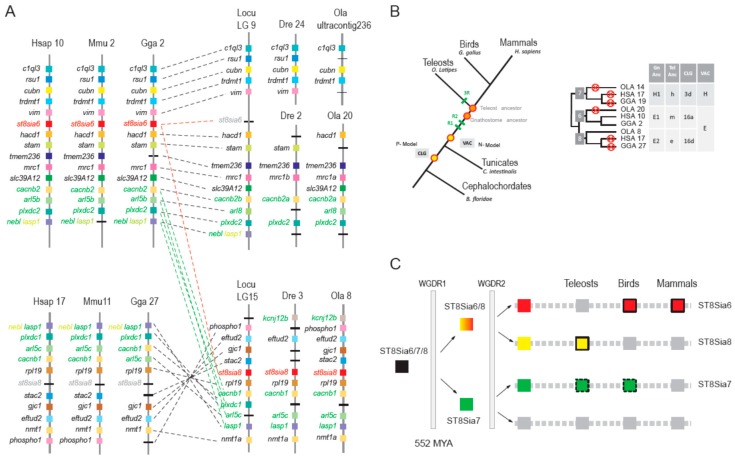Figure 7.
Evolutionary history of the st8sia6 and st8sia8 gene loci. (A) Syntenic relationships of the st8sia6 and st8sia8 gene loci in vertebrates. Chromosomal locations of the st8sia6 and st8sia8 and neighboring gene loci were determined in the human (Homo sapiens, Hsa), the mouse (Mus musculus, Mmu), the chicken (Gallus gallus, Gga), the spotted gar (Lepisosteus oculatus, Locu), the zebrafish (Danio rerio, Dre) and the medaka (Oryzias latipes, Ola) genomes. Putative orthologues were determined with information from the NCBI and ENSEMBL servers and visualized using the Genomicus 93.01 web site [73]. Paralogous genes in the vertebrate genomes are indicated in green, the st8sia6 and the fish st8sia6-like (i.e., st8sia8) gene loci are indicated in red or in grey when lost in the considered genome. (B) Reconstruction of ancestral genome to assess ST8Sia VIII subfamily origin. A schematic phylogenetic tree is shown on the left side to illustrate evolution of the chordate genome using the N-model [71,74] for the reconstruction of the prevertebrate ancestor (VAC, N-model) and the P-model [72] for the reconstruction of the prechordate ancestor (CLG, P-model). On the right side is a schematic illustration of the data obtained using the known genomic location of st8sia genes in O. latipes (OLA), in G. gallus (GGA) and in H. sapiens (HSA). Crosses indicate gene losses, Tel Anc indicates pre-3R teleost ancestor and Gn Anc indicates post-2R Gnathostome ancestor. (C) Schematic diagram illustrating the st8sia6/7/8 gene locus evolution after the two whole genome duplication (WGD) rounds. The ancestral gene st8sia 6/7/8 indicated by a black box gave two duplicates, the ancestral st8sia6/8 and st8sia7 genes after the WGD-R1, 552 MYA [35]. Four duplicated genes have arisen after the WGD-R2 event and st8sia6, st8sia8, st8sia7 were maintained in vertebrate genomes. The st8sia6 gene was lost in the Actinopterygii (ray-finned fish) genome and maintained in Sarcopterygii (lobe-finned fish and tetrapods), whereas the st8sia8 was lost in Sarcopterygii and maintained in Actinopterygii. A disrupted line frames the st8sia7 green box to indicate that this gene is not found in all teleost or bird species. Grey boxes indicate that the gene was lost in the branch.

